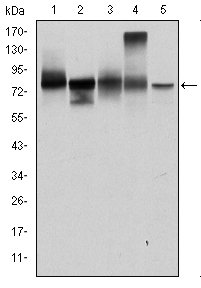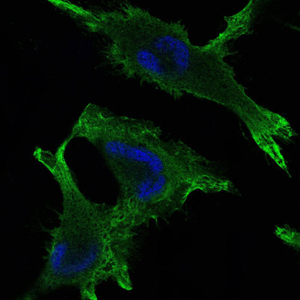Catenin-γ Monoclonal Antibody
- Catalog No.:YM0095
- Applications:WB;IHC;IF;ELISA
- Reactivity:Human
- Target:
- Catenin-γ
- Fields:
- >>Pathways in cancer;>>Transcriptional misregulation in cancer;>>Acute myeloid leukemia;>>Gastric cancer;>>Arrhythmogenic right ventricular cardiomyopathy
- Gene Name:
- JUP
- Protein Name:
- Junction plakoglobin
- Human Gene Id:
- 3728
- Human Swiss Prot No:
- P14923
- Mouse Swiss Prot No:
- Q02257
- Immunogen:
- Purified recombinant fragment of human Catenin-γ expressed in E. Coli.
- Specificity:
- Catenin-γ Monoclonal Antibody detects endogenous levels of Catenin-γ protein.
- Formulation:
- Liquid in PBS containing 50% glycerol, 0.5% BSA and 0.02% sodium azide.
- Source:
- Monoclonal, Mouse
- Dilution:
- WB 1:500 - 1:2000. IHC 1:200 - 1:1000. IF 1:200 - 1:1000. ELISA: 1:10000. Not yet tested in other applications.
- Purification:
- Affinity purification
- Storage Stability:
- -15°C to -25°C/1 year(Do not lower than -25°C)
- Other Name:
- JUP;CTNNG;DP3;Junction plakoglobin;Catenin gamma;Desmoplakin III;Desmoplakin-3
- Molecular Weight(Da):
- 82kD
- References:
- 1. Cell. 2009 Jul 23;138(2):389-403.
2. Cancer Res. 2009 Jul 15;69(14):5734-42.
- Background:
- This gene encodes a major cytoplasmic protein which is the only known constituent common to submembranous plaques of both desmosomes and intermediate junctions. This protein forms distinct complexes with cadherins and desmosomal cadherins and is a member of the catenin family since it contains a distinct repeating amino acid motif called the armadillo repeat. Mutation in this gene has been associated with Naxos disease. Alternative splicing occurs in this gene; however, not all transcripts have been fully described. [provided by RefSeq, Jul 2008],
- Function:
- disease:Defects in JUP are the cause of familial arrhythmogenic right ventricular dysplasia type 12 (ARVD12) [MIM:611528]; also called arrhythmogenic right ventricular cardiomyopathy type 12 (ARVC12). ARVD is an autosomal dominant disease characterized by partial degeneration of the myocardium of the right ventricle, electrical instability, and sudden death. It is clinically defined by electrocardiographic and angiographic criteria; pathologic findings, replacement of ventricular myocardium with fatty and fibrous elements, preferentially involve the right ventricular free wall.,disease:Defects in JUP are the cause of Naxos disease (NXD) [MIM:601214]. NXD is an autosomal recessive disorder combining diffuse non-epidermolytic palmoplantar keratoderma with arrhythmogenic right ventricular dysplasia/cardiomyopathy and woolly hair.,function:Common junctional plaque protein. The membrane-assoc
- Subcellular Location:
- Cell junction, adherens junction . Cell junction, desmosome . Cytoplasm, cytoskeleton . Membrane ; Peripheral membrane protein . Cytoplasmic in a soluble and membrane-associated form.
- Expression:
- Cervix carcinoma,Epidermal carcinoma,Epithelium,Leukocyte,Lung,Lung carcinoma,Place
- June 19-2018
- WESTERN IMMUNOBLOTTING PROTOCOL
- June 19-2018
- IMMUNOHISTOCHEMISTRY-PARAFFIN PROTOCOL
- June 19-2018
- IMMUNOFLUORESCENCE PROTOCOL
- September 08-2020
- FLOW-CYTOMEYRT-PROTOCOL
- May 20-2022
- Cell-Based ELISA│解您多样本WB检测之困扰
- July 13-2018
- CELL-BASED-ELISA-PROTOCOL-FOR-ACETYL-PROTEIN
- July 13-2018
- CELL-BASED-ELISA-PROTOCOL-FOR-PHOSPHO-PROTEIN
- July 13-2018
- Antibody-FAQs
- Products Images

- Western Blot analysis using Catenin-γ Monoclonal Antibody against T47D (1), MCF-7 (2), SKBR-3 (3), A431 (4) and HEK293 (5) cell lysate

- Immunohistochemistry analysis of paraffin-embedded rectum tissues with DAB staining using Catenin-γ Monoclonal Antibody.

- Immunofluorescence analysis of U251 cells using Catenin-γ Monoclonal Antibody (green). Blue: DRAQ5 fluorescent DNA dye.




